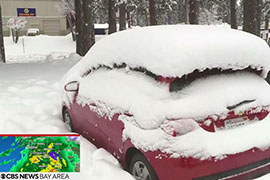By Daniel Ogas and Karina Romero
Cronkite News
LOS ANGELES – After watching billions of gallons of rainwater wash away into the Pacific, California is taking advantage of extreme weather with a new approach: Let it settle back into the earth for use another day.
As the latest batch of storms lashed the Golden State, California Gov. Gavin Newsom signed an executive order this week to hasten projects that use rainwater to recharge aquifers, reversing decades of an emphasis on channeling it into drains and out to sea.
“California is seeing extreme rain and snow, so we’re making it simple to redirect water to recharge groundwater basins. This order helps us take advantage of expected intense storms and increases state support for local stormwater capture efforts,” Newsom said in a statement.
Even apart from the order, the state had already committed $8.6 billion to the effort.
The order to allow water agencies to do a better job of capturing runoff came amid a storm season that has dramatically refilled reservoirs drawn down by a drought that produced the driest three years on record. The Metropolitan Water District of Southern California just lifted watering restrictions on 7 million residents as fewer regions report desperately dry conditions.
It also could help reduce Southern California’s dependence on importing water from other parts of the state and from the Colorado River, in which Arizona, California and other Western states are vying for the biggest possible states of a depleted flow.
The MWD, in announcing the easing of restrictions but urging continued conservation, warned of “potential steep cuts to supplies from the Colorado River” despite the wet year.
With the latest storms, downtown Los Angeles has seen 31.6 inches of rainfall since the official start of the season Oct. 1, the Los Angeles County Department of Public Works reported. Normal is 17.8 inches.
Saving as much of that water as possible for reuse later, along with continuing conservation, are considered critical.
The state’s Sustainable Groundwater Management Office says recharging aquifers is a key strategy to deal with climate-driven weather extremes, whether it is drought or periodic intense storms.
But it’s not easy to coax rainwater back into the ground. It can often involve creating new lakes or settling basins.
Groundwater recharge efforts occur at a much slower rate than surface water runoff, the groundwater management office reports. It will take years of recharging to replenish the impacts of the drought.
As legislative efforts ramp up to respond to such extreme weather events across the state, the question of how these efforts will affect communities is top of mind for Californians.
Taking the long view, “there’s less water in the system.” said Laurel Firestone, a member of the State Water Resources Control Board. “By recharging, capturing stormwater and recycling water, we are having more local supplies.”
The replenished supplies in the state include the snow pack, which was at 223% of normal this week and could help provide water late into the year as it melts. The additional water running through California could buy time for the state to help solve its water issues. It’s yet to be seen how it affects distribution from the Colorado River.
“A lot of what Southern California is trying to do is become less dependent on the Colorado River,” Firestone said.
Firestone made it clear that issues on the Colorado River are both short- and long-term.
“It’s driven by our changing climate,” Firestone said.
Jessica Bean of the California State Water Resources Control Board said the reuse issue is so critical because so much groundwater has been depleted, not just by California’s millions of residents but also by the state’s vibrant agricultural sector.
“Many of our groundwater aquifers are overdrafted so when it comes to unexpected weather we want to manage that recharge to better utilize the excess amounts of water,” she said. “The point that we want to create is that one wet year is not going to solve all our problems.”
For more stories from Cronkite News, visit cronkitenews.azpbs.org.
^__=
California has been hit with unusually high levels of rain and snow this winter, with snowpack at more than twice normal levels. With the state in the grips of a multiyear drought, state officials are hoping to capture some of the runoff and snowmelt to recharge depleted reservoirs and aquifers. (Photo by KPIX via. CNN)
